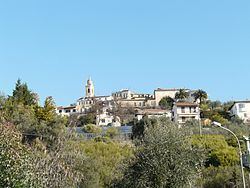Demonym(s) Seborghini Area 4.91 km² Local time Sunday 1:49 AM Dialling code 0184 | Elevation 500 m (1,600 ft) Time zone CET (UTC+1) Postal code 18012 Patron saint Bernard of Clairvaux | |
 | ||
Weather 4°C, Wind W at 19 km/h, 91% Humidity | ||
Seborga is a small town in the region of Liguria in northwest Italy, near the French border. Administratively, it is a comune of the Italian province of Imperia. The main economic activities are horticulture and tourism.
Contents
- Map of 18012 Seborga Province of Imperia Italy
- Economy
- Culture
- Transport
- Principality of Seborga
- References
Map of 18012 Seborga Province of Imperia, Italy
The town is notable for claims of independence from Italy as the sovereign Principality of Seborga.
Economy
Seborga is known in the region for its agricultural activity: in particular, cultivation and collection of olives and floriculture crops. Thanks to Seborga's publicity as a principality, tourism has expanded in recent years. The principality's historic town centre was also restored, ensuring that its charms were protected from commercial overdevelopment.
Culture
An important cultural event in Seborga is the annual festival of Saint Bernard, the town's patron saint, held on August 20. Seborga's twin city is L'Escarène, France. The festival includes a procession of citizens and the carrying of a statue of Saint Bernard. The national anthem of Seborga, titled "The Hope", was composed by HSH Prince George I and set to music by Maestro Luigi Poggi of Bordighera in 1994.
Transport
Seborga is situated along Provincial Road 57 in Imperia. The nearest motorway access is at the Bordighera exit on the A10. The nearest railway station is also the one in Bordighera, on the Ventimiglia-Genoa line.
Principality of Seborga
In the early 1960s, Giorgio Carbone, then head of the local flower-growers co-operative, began promoting the idea that Seborga retained its historic independence as a principality. By 1963 the people of Seborga were sufficiently convinced of these arguments to elect Carbone as their ostensible head of state. He then assumed the self-styled title Giorgio I, Prince of Seborga, which he claimed thereafter.
Carbone's status as prince (although without any legal power) was further supported by locals on 23 April 1995, when, in an informal referendum, Seborgans voted 304 in favour, 4 against, for the principality's constitution, and in favour of independence from Italy. Carbone reigned until his death on 25 November 2009. The prince was known locally as Sua Tremendità ('His Tremendousness').
Prince Girogio Carbone reigned until his death at the age of 73. He died on 25 November 2009. The following year the Principality held its first election for a new Prince. There were five proposals, of whom two, Marcello Menegatto and Gian Luigi Morgia, were nominated by council as candidates. Elections were held on 24 and 25 April 2010. Out of a total of 220 eligible voters, 89 voted for Menegatto and 67 voted for Morgia, making Menegatto the new Prince of Seborga. 31 year old Menegatto was crowned Prince in a ceremony held on 22 May 2010. He will have a seven year reign after which new elections will be held.
The Republic of Italy and international institutions consider and treat Seborga as an integral part of the territory of Italy. Law enforcement, public health, telecommunications, school services and all other public services are provided as in the rest of Italy. Seborgans regularly pay taxes, participate in the Italian administrative life, and vote in local and national (Italian) elections. For instance, in the elections of the Senate in 2001 the voter turnout was 84.21%.
